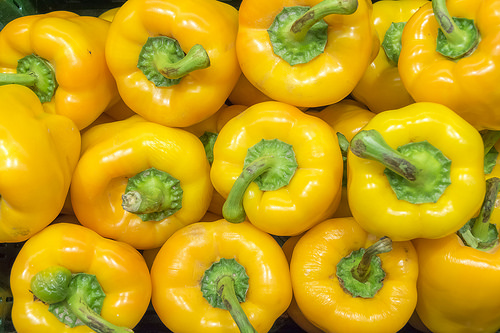I like sweet peppers in my salads. I like it in my chopseuy and atchara. A lot of people like sweet peppers for its taste and it is highly prized by people fond of preserving food, especially pickles. These sweet peppers (Capsicum anuum L.) are expensive in this country.

Capsicum, however, is plagued by fungal infections caused by Sclerotium rolsii and Rhizoctonia solani and these pathogens cause reddish brown lesions at the base of the stem of damped-off seedlings. This spells trouble for farmers trying to raise and earn from sweet peppers.
S. rolfsii is a fungus that causes seedling blight, stem rot, and root rot. It has a cottony or fluffy appearance on stems under moist conditions that may apparently disappear as sunlight penetrates the leaf canopy and dew evaporates. Entire branches on plants may wilt and die as a result of the fungus, at which time the fungus produces small black, irregularly shaped sclerotia (compact usually dark-colored mass of hardened mycelium constituting a vegetative food-storage body in various true fungi; detaches when mature and can give rise to new growth) that provide positive recognition.
Researchers Fema P. Mariano and Naomi G. Tangonan from the University of Southern Mindanao (USM) in Kabacan, Cotabato looked into ways of eliminating these diseases. Other scientists discovered that some fungi are effective in controlling other fungal species and the USM researchers are tapping into this knowledge. “Ectomycorrhizal association (a symbiotic relationship between plant root cells and fungi) to some extent may control soil-borne pathogens (organism which can cause disease in another organism),” Mariano and Tangonan said, “though it is a mutualistic association between higher fungi and gymnosperm (a plant that bears naked seeds like the common pine and hemlock) or angiosperm (a flowering, fruit-bearing plant or tree) plants belonging to certain families.”
Mariano and Tangonan explored the possibility of some fungi belonging to the group Basidiomycetes as possible bio-control agents. Though some Basidiomycetes are not mycorrhizal, the use of these fungi for bio-control is probable. These fungi have macroscopic (visible to the naked eye) fruiting bodies that resemble crusts, shelves, or mushrooms and most of them feed on or grow upon decaying animal or vegetable matter. They are also abundant the whole year in the Philippines so supply may not be a problem.
The USM researchers conducted the study from September 2001 to January 2002 and tested the effectiveness of seven Basidiomycetes (Rigidoporous sp., Phellinus sp., Auricularia sp., Schizophllyum sp., Lactarius sp., Fomes sp., and Armillaria sp.) against the pathogen S. rolfsii.
Results showed that the seven fungi were effective in antagonizing or suppressing S. rolfsii that causes damping-off in sweet pepper. There was a high difference compared to benomyl (chemical control) and the untreated samples.
The percentage germination of sweet pepper infected with S. rolfsii was higher with the help of Basidiomycetes. The test with Schizophyllum sp. gave the highest number of seedlings germinated and this was also comparable with tests with Auricularia sp. and Fomes sp.
Schizophyllum sp. had the lowest percentage of damped-off seedlings (29.50%) compared to Auricularia sp. (40.25%), Lactarius sp. (42.0%), Fomes sp. (40.25%), Armillaria sp. (43.25%)k, and Phellinus sp. (45%). The chemical control benomyl had 45.75% damped-off seedlings.
The Basidiomycetes suppress the growth of the pathogen, the researchers concluded. The efficacy or effectiveness in the screenhouse test in increasing percentage germination of sweet pepper seedlings infected with S. rolfsii and decreasing the damping-off incidence is now established with this study.
Further studies using these seven Basidiomycetes against other plant pathogens are possible and other genera of Basidiomycetes may be explored to control fungal pathogens causing diseases in agricultural crops.
——————————-
References:
1. Mariano, F.P. and Tangonan, N.G. Evaluatiion of Seven Basidiomycetes Against Sclerotium Rolfsii Sacc. Causing Damping-off of Sweet Pepper. USM CA Res. J. 13(1): 103-113 June 2002.
2. Mycorrhyiza, pathogen, agriosperm, gymnosperm, sclerotia definitions. Http://www.hyperdictionary.com
3. Sclerotium rolfsii. Http://www.agrobiologicals.com
By: Likha C. Cuevas, BAR Digest, July-September 2003 Issue (Vol. 5 No. 3)
